- News
- Reviews
- Bikes
- Accessories
- Accessories - misc
- Computer mounts
- Bags
- Bar ends
- Bike bags & cases
- Bottle cages
- Bottles
- Cameras
- Car racks
- Child seats
- Computers
- Glasses
- GPS units
- Helmets
- Lights - front
- Lights - rear
- Lights - sets
- Locks
- Mirrors
- Mudguards
- Racks
- Pumps & CO2 inflators
- Puncture kits
- Reflectives
- Smart watches
- Stands and racks
- Trailers
- Clothing
- Components
- Bar tape & grips
- Bottom brackets
- Brake & gear cables
- Brake & STI levers
- Brake pads & spares
- Brakes
- Cassettes & freewheels
- Chains
- Chainsets & chainrings
- Derailleurs - front
- Derailleurs - rear
- Forks
- Gear levers & shifters
- Groupsets
- Handlebars & extensions
- Headsets
- Hubs
- Inner tubes
- Pedals
- Quick releases & skewers
- Saddles
- Seatposts
- Stems
- Wheels
- Tyres
- Health, fitness and nutrition
- Tools and workshop
- Miscellaneous
- Buyers Guides
- Features
- Forum
- Recommends
- Podcast
feature
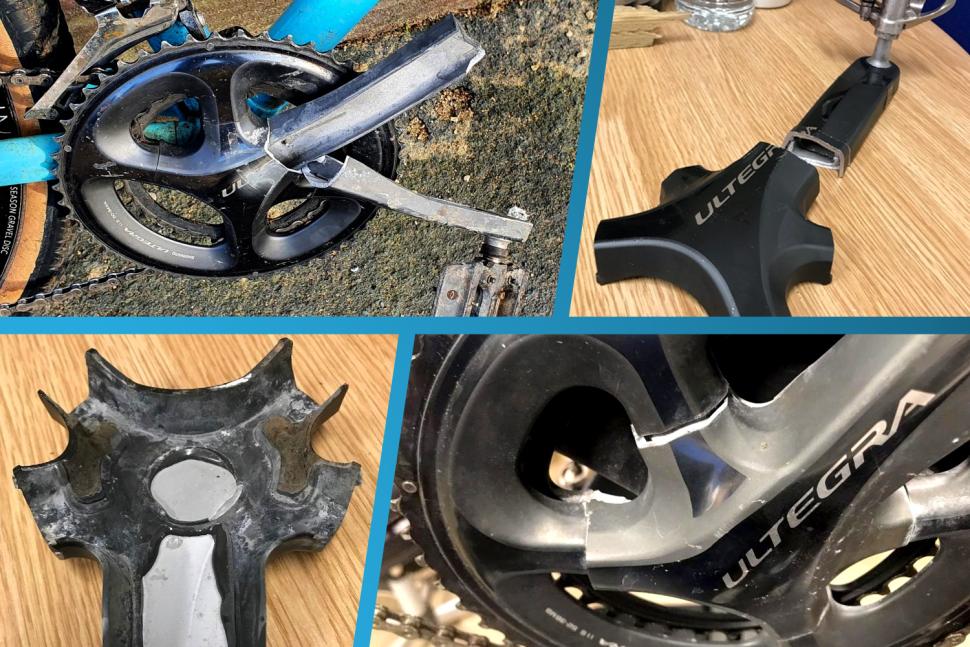 Investigating Shimano’s snapping cranksets Sept 2023
Investigating Shimano’s snapping cranksets Sept 2023Investigating Shimano’s snapping cranksets: What happened, unanswered questions and an engineer's report
Since first publication, this article has been updated with responses from Shimano. The updates can be found in the editor's note at the bottom of the article.
For quite a few years now, we've been hearing stories of cyclists whose Shimano Hollowtech cranksets were snapping underneath them, and felt it was a problem that was too big to ignore. We published a number of articles highlighting the issue, and sent out a request for those affected to email us with pictures and stories about their misfortune. In addition, we sent off some of the broken cranksets to a mechanical engineer at the University of Greenwich to better understand the issue.
road.cc received its first email from a reader about a snapped Shimano crankset in 2018, but there are forums online that date back further documenting the same issue. Long-time road.cc contributor John Stevenson sent out our first request for readers to email us with descriptions and pictures of crankset failures, and to date we've received hundreds.
In 2021, Shimano said it was "investigating" the problem, but it is only now that the Japanese corporation - by far the biggest manufacturer of bike components in the world - has officially acknowledged that there's an issue with the design of its bonded aluminium Hollowtech cranksets, issuing a recall in North America and - at the time of writing - an inspection program for the rest of the world.
The affected products are Dura-Ace and Ultegra branded cranksets produced between 2012 and 2019, with the following model numbers: Ultegra FC-6800 and FC-R8000, and Dura-Ace FC-9000, FC-R9100, and FC-R9100-P. Customers can go to the Shimano website to check the manufacturing code. If your crank doesn't match both the model number and manufacturing code, Shimano says that "no further action is required."
These cranksets all feature a hollow aluminium construction, which aims to reduce the weight of the crank without reducing its strength and rigidity.
The cranks on lower tiered road groupsets - Shimano 105, Tiagra, Sora and Claris - don’t appear to be failing, most likely because they don’t use the same two-piece construction. As far as we know, the new 12-speed Dura-Ace and Ultegra cranksets are not affected due to a change in the design.
The changes to the latest Dura-Ace and Ultegra cranksets had previously led us to believe that Shimano was already aware of the issue with some of its previous generation cranksets long before its official acknowledgement. That the recall/inspection program only affects cranksets made between 2012-2019 may also suggest the affected models made post-2019 have had some modifications to reinforce them, although Shimano hasn't really commented on this.
What's actually been happening?
I stood up out of the saddle to hasten my trip home as the noise was irritating me, and the next thing I remembered, I was somersaulting head first into the tarmac, landing in the middle of the road, straddling the white line. I quickly got to my feet, unaware of what had happened, just in time before a car came streaming down the road.
This seemingly endemic failure has happened to thousands of people around the world, sometimes to the same person more than once.
Previously, we were unable to provide official numbers of exactly how many cranksets have failed, but the official number of documented cases is over 4,000. It is thought the recall in North America and global inspection programs elsewhere are likely to affect 2.8 million units globally.
I slowed, couldn't see anything, and one mile later another metallic noise. I started for home and just after a little effort my cranks cracked... I'm 65 with the power of a marshmallow. How can this be?
We shared a photo on our Facebook page back in May which received over 1000 comments detailing similar incidents. There is also a whole Instagram account dedicated to the failure of Shimano components, @thanksshimano, which has 17.7k followers and new posts regularly.
So, what do we know?
From the emails and pictures we’ve seen, the failures are similar every time. Debonding occurs on the driveside, there is cracking on the arms of the spider, and then the crank arm fully detaches as the outer shell comes away.
Another common fault location is cracking on the inside of the driveside crank arm. Non-driveside crankarm failures have also been reported, but there are far fewer documented to our knowledge.
I stopped riding after the cranks began creaking badly. At first, I thought it was the BB, but the bike shop said the driveside crank had come apart.
From the testimony road.cc has received from readers, there aren’t always warning signs as to when a crankset is going to fail, but we do know that issues appear to start out as a creaking that riders aren't able to get to the bottom of.
After failing to find the problem my crank arm literally snapped off on a downstroke while going downhill. Not my finest or most graceful moment.
Other telltale signs can be pedals feeling like they are misaligned or bent. There also doesn't seem to be a particular pattern as to how far one must ride before a failure occurs, but the failures are always on well-used cranksets. This could explain why the issue has never arisen in the top levels of professional cycling, where equipment will be new or nearly new, more often than not.
What could the problem be?
Without knowing exactly what Shimano's manufacturing or design process was for the affected cranksets, it is difficult to say what the root cause is, but there are numerous possible explanations for why this might be happening.
Shimano’s primary manufacturing plants are in China, Malaysia and Singapore, which can all be very humid depending on the time of year. Therefore, the environmental conditions are critical for the components and processes.
The main theory is because of corrosion, which has the potential to result in a complete structural failure like many cranksets we have seen. This corrosion has been associated with temperature change and damp climates which can affect the bonding agent which holds the parts together.
Another theory is that it could be due to issues with fusing between the halves of the crankset, which would come down to the bonding method.
We have seen plenty of cases here in the UK, but most failures appear to be from tropical and subtropical zones. Could it be that temperature and humidity accelerates the corrosion of the adhesive?
Expert analysis
In an effort to find out if those theories might be correct, road.cc sent two failed Shimano cranksets to Dr Mark Bingley, the Principal Lecturer and Programme Leader for Mechanical Engineering at the University of Greenwich, for further investigation. Failure 1 was a bending of the crank arm, and Failure 2 was the complete fracture of the crank arm.
The investigation involved:
- Carrying out a Vickers hardness test (this page provides a good explanation of what this test involves) on a section of the crank arm to determine the approximate strength of the material
- Making general visual observations
- Using a scanning electron microscope (SEM) to determine the approximate composition and grade of material
Early findings indicate that a critical initial stage in the failure of the cranksets involves the partial separation of the inner and outer U-shaped channels, which together form the rectangular tube section of the crank arm.
During the final failure, the fracture path followed the interface between the adhesive and the metal substrate, and Dr Bingley found that adhesive material remained attached to the inside surface of only the outer channel indicating that the adhesive did not fully bond or adhere to the metal.
Corrosion of the metal substrate can weaken adhesive bonds, but interestingly no evidence of corrosion was found on the areas of separation on the parts examined.
When satisfactorily bonded, the section is of adequate strength to resist loads of up to around 224kg. However, if partial debonding occurs between the parts, the crank arm is significantly weakened and a mass of 43kg could have been sufficient to cause bending failure of the upper/inner channel of these cranksets. This failure could occur suddenly and without warning.
No conclusions, however, have yet been made concerning how debonding between the two U-shaped channels initiates. Flaws resulting from the manufacturing process, environmental deterioration and fatigue have all been considered as possibilities. Whichever is at fault, such partial debonding of the two channels is a notable weakness that might eventually lead to gross failure.
Dr Bingley concluded that any proposed solution to the problems noted in the study will depend on how frequently failures occur. If rarely, then this might be considered acceptable by the manufacturer. If it is a frequent problem the recall of the product and a redesign will be necessary. Fortunately, Shimano has now taken action.
What does Shimano have to say?
We can only assume that Shimano has been aware of this problem for a number of years, only now officially acknowledging it by issuing a recall of the relevant cranksets in North America, and a global inspection program elsewhere.
The company says that inspections will occur at Shimano-authorised retailers, and any crankset that does not pass the inspection process will be replaced free of charge. This replacement "will be a special version, which may feature a different cosmetic appearance while maintaining the same level of performance", images of which you can see towards the top of this article.
The announcement also states that if your crankset passes the inspection and has no signs of delamination, then you can "...continue to enjoy your ride. Have your bike tuned up and inspected regularly, ask your dealer for recommendations based on your riding habits. Pay attention to changes in the sound and feel of how your bike is riding."
As discussed in the podcast episode, the differences between an official recall issued by the United States Consumer Product Safety Commission and a less-official 'inspection program' elsewhere poses its own problems, and we're also not fully aware of what tests mechanics will have to perform to determine whether potentially affected cranksets are safe to use or not. Shimano tells us that more details are coming, but at the time of writing there is still some confusion and uncertainty for distributors, bike shops and customers.
Conclusion
Dr Bingley's findings suggest that the initial stage of the failure process involves partial failure of the adhesive bond between the two channels. Despite corrosion being a known factor that can weaken adhesive bonds, there was no evidence of corrosion found on the examined parts.
Given the limited sample size, a more comprehensive investigation would be required to determine the root causes of these failures.
Here is his conclusion in full:
In both crank arm failures, it can be concluded that an essential preliminary stage in the failure is the partial debonding of the inner and outer U-shaped channels that together make up the rectangular tube section of the crank arm. When satisfactorily bonded the section is of adequate strength to resist any loads that it commonly sees. However, if partial debonding occurs between the parts the upper/inner channel is vulnerable to the size of loads that may commonly be applied during use.
No conclusions were possible as to how debonding between the two U-shaped channels initiated. Flaws resulting from the manufacturing process, environmental deterioration and fatigue were all considered as possibilities. Whichever was at fault, such partial debonding of the two channels is a notable weakness that might eventually lead to gross failure.
Any proposed solution to the problem will depend on how frequently failures occur. If rarely, then this might be considered acceptable by the manufacturer. If it is a frequent problem the recall of the product and a redesign will be necessary. The simplest and cheapest solution would be to reinforce the adhesive bonds with mechanical fixings. However, this might not be considered acceptable for aesthetic reasons.
While many cyclists - us included - have been somewhat disappointed with Shimano's handling of this issue, it is important to consider that there are millions of these cranksets out there, and many will have been used and abused for thousands of miles without issue. Shimano has sold a vast number of them over the years, so it’s almost inevitable that there will be some reported failures. It would be interesting to see the number of incidents versus the number sold, but we have no way of getting these figures.
Prior to this, the last time Shimano recalled any of its cranksets was in 1997 in the US - FC-CT90, FC-M290 and FC-MC12 - with more than 630 reports of cranks breaking in North America. We discuss other recalls in the bike industry in our podcast episode embedded towards the top of this article, and while this one affects more units than we've ever seen in recent times, there have been reports of severe injuries and even deaths linked to other cycling products that have been recalled in the past, such as the Kinesis Racelight TK2 fork.
Before the official recall (North America) and global inspection program, numerous people had already had their cranksets replaced by Shimano, and we've also been made aware of cases where cranks were replaced outside of their warranty period on the expectation that they should last for a "reasonable length of time".
However, a replacement hasn’t often been enough to restore these individuals’ confidence, and many people said that they wouldn’t be using the replacement cranksets, instead purchasing from elsewhere. Two readers said:
I'm so put off bikes now with Shimano cranks, it's a shame as the rest of their components are great.
Shimano replaced the crank fully 4 months later but I’ve decided not to use it as there are other products equally as good and don’t have the same history of failure.
Shimano's challenge remains even with an official acknowledgement of the issue: can it fully regain consumers' trust in its products?
Dr Bingley's full report can be found here.
Editor's note (updated 4/10/23): Special thanks to John Stevenson, Grahame Baker and Dr Mark Bingley for their help and expertise during the production of this article. We'd also like to thank the hundreds of you who contacted us and even sent cranksets to the office for Dr Bingley's report. Sorry we couldn't reply to all of you!
While the findings aren't conclusive and, as the title suggests, we still have unanswered questions over this saga, we hope you've found the article informative. If just one person reads it and takes their bike for inspection before a possible failure occurs, the article has done its job.
road.cc had been in contact with Shimano prior to the publication of this article. We asked: 1) Why there was a difference between the recall in North America and inspection program elsewhere; 2) What the root cause of the failures were; 3) What the inspection procedure involved for mechanics.
Shimano responded:
[Question 1]: "Shimano has been working closely with both the American Safety Authorities (CPSC) and their counterparts in Europe (specifically in the Netherlands, the NVWA), however we are unable able to provide specifics on the processes. This is due to the regional differences between safety authorities and their own risk assessment processes of the affected products. We were required to adhere to their respective requirements."
[Question 2]: “Cranksets can and do break for a variety of reasons. The affected bonded cranksets have been reported to separate and break on rare occasions, thus posing a crash hazard to consumers. While it is difficult to draw firm conclusions from a small sample, Shimano has made numerous changes, improvements, and enhancements in response to the market information we are receiving. This is standard practice at Shimano."
[Question 3]: “We are pleased to see Shimano Dealers’ reactions around Europe. We recognize that this will require a tremendous amount of effort by the dealers to ensure the program will succeed. The response thus far has been supportive of our voluntary inspection program for the affected cranksets. The full Crankset Inspection instructions can be found online in this manual. Our dealers will also have access to online learning materials via our online learning platform Shimano T.E.C., which covers the most important information about identifying and inspecting affected cranksets, as well as submitting their inspection results. The course will be extended with more modules over the coming days and weeks and will also be made available to not only authorized dealers, but independent bike dealers as well.”
Since the Office for Product Safety & Standards (OPSS) concluded that the affected Shimano cranksets do not meet the requirements of the General Product Safety Regulations 2005 in its product safety report, road.cc is calling for an official recall to be filed with the OPSS in the UK.
What do you think about these findings, and will you stop using the affected Shimano cranksets as a result? Let us know in the comments section below.
Emily is our track and road racing specialist, having represented Great Britain at the World and European Track Championships. With a National Title up her sleeve, Emily has just completed her Master’s in Sports Psychology at Loughborough University where she raced for Elite Development Team, Loughborough Lightning.
Emily is our go-to for all things training and when not riding or racing bikes, you can find her online shopping or booking flights…the rest of the office is now considering painting their nails to see if that’s the secret to going fast…
Latest Comments
- Fergus_O'Hara 0 sec ago
I did, I just think he's full of s***
- i-am-furious 16 min 32 sec ago
Cycling is not a lawless act, because its totally lawful to kill a cyclist....
- mark1a 36 min 34 sec ago
Energy from the Severn - it's always baffled me why one of the highest tidal ranges in the world can't be harnessed for a clean, predictable and...
- David9694 1 hour 6 min ago
My cleaning go-to is old t-shirts. I've got mixed feelings about the fluff of microfibre towel; tea towels not so much as they don't have the bit...
- HLaB 1 hour 23 min ago
Inventive Journalism "Car Collides with wall", lazy journalism would have been 'Crashes' ...
- carefulrider 1 hour 26 min ago
Two points of clarification....
- Secret_squirrel 2 hours 39 min ago
Unlikely IMO. They've already pretty much run out of parliamentary time. Only statutory instrument stuff could get done now.
- Ianbb 2 hours 49 min ago
Good luck Dave. May well see you there. Hopefully the weather will be like it is this week!
- ktache 2 hours 51 min ago
Well done for Reading cyclists for being so welcoming.
- ymm 3 hours 11 min ago
Looking forward to seeing the frothing right wingers wading into this, along with Mark Harper of DfT fame with a suitably unhinged viewpoint...
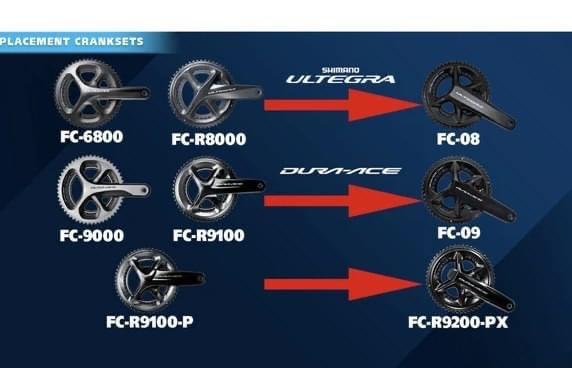

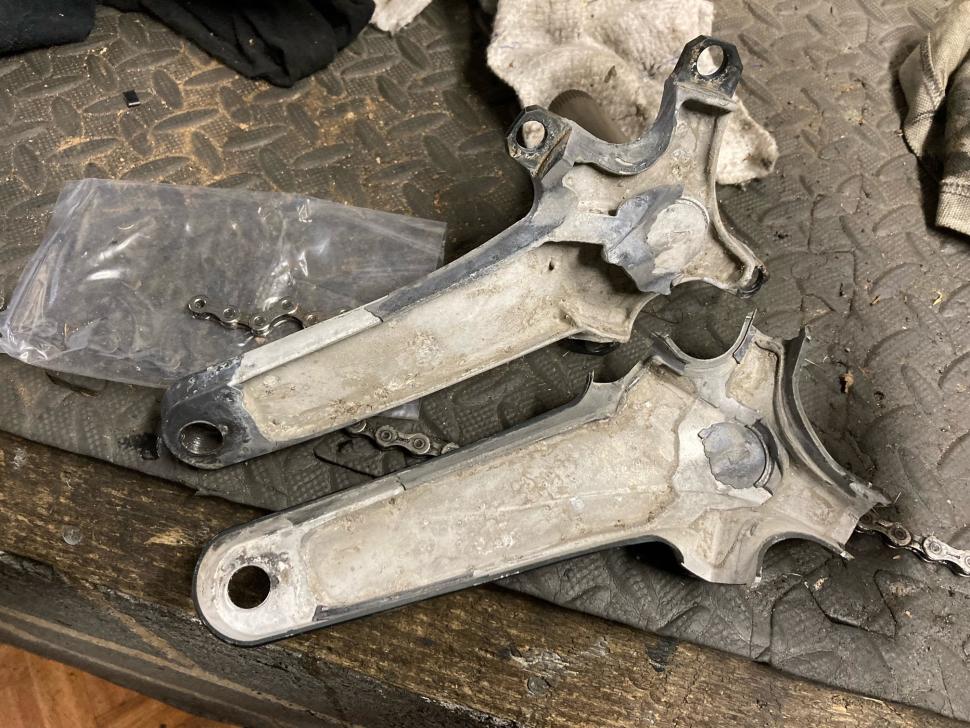
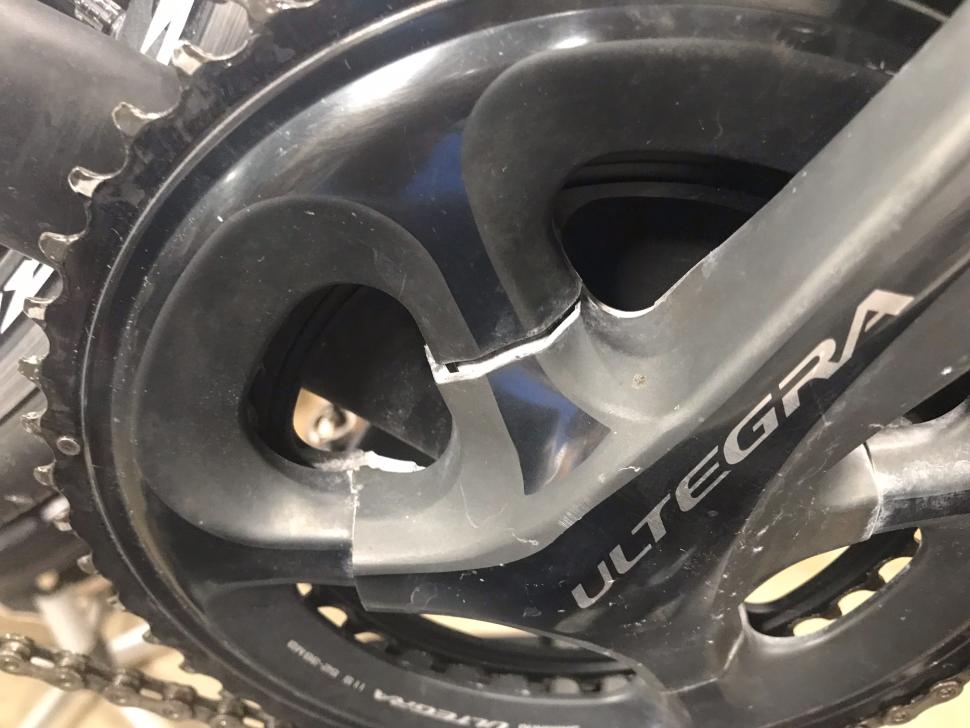
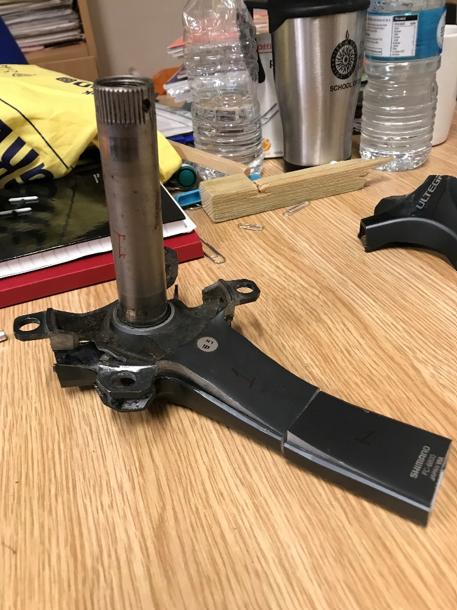
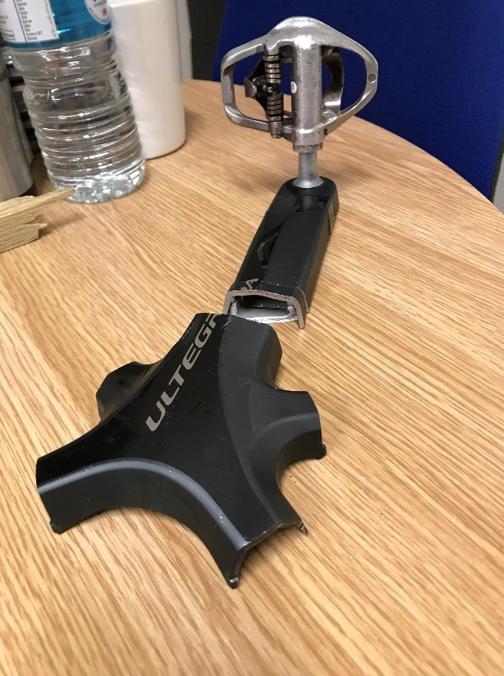



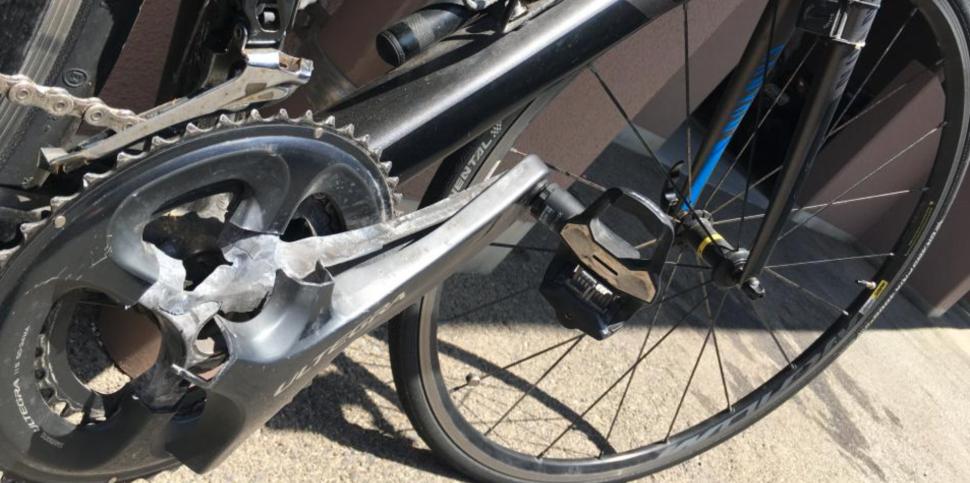
Add new comment
15 comments
https://www.gov.uk/product-safety-alerts-reports-recalls/product-safety-...
i was always skeptical to these cranks, and would not have accepted them on a bike of mine.
mainly because of their extremely cheap massproduced moulded look. typical for entry warehouse bikes, and indicative for low quality in general terms. this in contrast to machined or smithered components with a more raw look, more attractive to me, and in general terms speaking of a manufacturer that put some effort into the product.
well it seems my intuition guided me in the right direction.
The strange moulded look of these cranks never appealed to me either. They look strange. They don't look solid. They look like cheap cranks on supermarket bikes with the big plastic covers, except it's metal.
I also hate the new bolt-pattern cranks. Completely done to fuck up the ancillary markets in spare parts, and for the marketing selling-point of having different, "new" aesthetics.
And then to find they /glued/ these cranks together, to get light-weight on the cheap. Ick, ick, ick.
"Shimano’s primary manufacturing plants are in China, Malaysia and Singapore, which can all be very humid depending on the time of year."
D-A and Ultegra are made in Japan aren't they?
Engineer here. I was always taught to avoid bonding if at all possible in my industry as a primary fixing method. Bonding is fantastic but the process has to be spot on and paying for it is often expensive when another method would do. Cleaning and temperature are key if you get it wrong it can fail. I wanted to do some bonding at a manufacturer in India and was advised to avoid as the air quality in certain cities was terrible and would contaminate the bonds and we couldn't garantee the supplier would follow the correct processes. All comes down to money ultimately.
Engineer here. I was always taught to avoid bonding if at all possible in my industry as a primary fixing method. Bonding is fantastic but the process has to be spot on and paying for it is often expensive when another method would do. Cleaning and temperature are key if you get it wrong it can fail. I wanted to do some bonding at a manufacturer in India and was advised to avoid as the air quality in certain cities was terrible and would contaminate the bonds and we couldn't garantee the supplier would follow the correct processes. All comes down to money ultimately.
Agreed. I had some experience of bonding in Aerospace, and it is an excellent solution there - no fasteners is not only fewer processes (=cheaper) but also fewer stress risers. Airbus are essentially glued together. However, it does need the strict process and QA, and clean environment.
It must have been obvious to Shimano engineers there was a problem, I don't understand how they let it go for so long.
Agreed. I had some experience of bonding in Aerospace, and it is an excellent solution there - no fasteners is not only fewer processes (=cheaper) but also fewer stress risers. Airbus are essentially glued together. However, it does need the strict process and QA, and clean environment.
It must have been obvious to Shimano engineers there was a problem, I don't understand how they let it go for so long.
My crankset snapped a few weeks ago while I was riding . It was making a clicking noise for a few days but I couldn't see what the problem was . I knew nothing about the problem with shimano until a few days ago when I read an article about it , I had a new one fitted . What happens to all the cyclists that have had to pay for theirs to be replaced ?
I was aware of the problem but when mine failed last year (I had an annoying creaking for a while before it went) as it was a 2nd hand crank they wouldn't sort me out
I would like to know what will happen in the future. My Dura-Ace FC-9100 crank is an 'OM'. I have inspected it according to Shimano's own video and there are currently no signs of any fatigue or cracks. What if it fails in 18 months or in 3 years time will Shimano still replace it?
Considering a crankset is a critical component when it comes to rider safety, and considering Shimano has a good reputation, one would have thought The Big S would have done the right thing right away. Instead of letting the issue grow, for years.
It's like if Ford would discover that occasionally the steering wheel of a certain car model would detach while driving. And then would say, hey, let's just neglect this. And let's build build another few 100.000's with the same issue... Because, eventually, the model will be discontinued anyways.
In fact the Ford Pinto was sold with a fuel system known to have a risk of causing fires, but the company brought it to market anyhow, based on a cost-benefit analysis.
Hope the lab refunded your money, they've told you nothing that was not already obvious.
One of the main theories for the cause of the failures was corrosion, but no significant corrosion was found in the points of failure on both sets of cranks tested which we thought was pretty interesting. We are considering sending more off for analysis if Shimano's own investigations don't confirm the exact cause in the coming months.